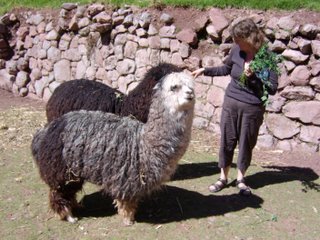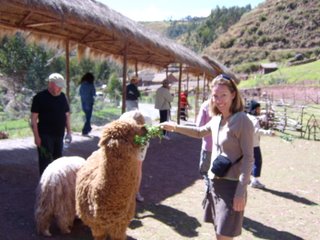




There is so much to say about my trip to Peru that I have decided to tackle single elements, rather than attempt to convey all of my thoughts in one blog. Today's subject is of a wooly nature.
Being from Yorkshire, I am used to seeing wooly backed creatures in nearly as much abundance as humans. In fact, yorkshiremen are often accused of loving their sheep more than their fellow men. I'm not sure that our affinity with sheep goes this far, although I wouldn't be surprised if a sheep was picked before a chap from "the wrong side of pennines" (Lancashire) by a yorkshireman faced with the old small lifeboat and crowd of people/animals to save addage, pero bueno (as the Spanish would say). Anyway, what I'm trying to say is that I wasn't overly surprised at the quantity of wool wandering around.
As you can see from the photos, we went to a LLama / Alpaca sanctury, in an attempt to familiarise ourselves with the varieties of the species. However, I'm afraid no one really quite got the hang of it. There are so many different types! Llamas and alpacas are effectively brothers from what I can see, but I can't remember who their parents were in the vast family tree of wool. The family tree showed that within both the Llama and the Alpaca group there are many different types - this is what makes each one that passes you by difficult to name. You see one that you think is definitely a llama and then his fury friend walks by who defintely doesn't look like an alpaca, but yet doesn't look like the one you thought was a llama. Its all down to hairstyles really. There are rastas even in the llama/alpaca world!
my distinguishing rule of thumb was as follows: thoe with mad hair dos are llamas, and those which look more like sheep (albeit with very long legs and necks) are alpacas. Its the later that have the most expensive wool, and so are more valuable. Wool aside, their value in Cusco seems to be related to their ability to smile for the camera. A traditionally dressed woman or child is no one in the tourist photo industry if she doesn't have a llama or alpaca at her side.
One story related to llamas that I didn't much like was the one about the sacrifices that takes place every year up at the temples just outside Cusco. These sacrifices are part of Inka festivals that are still practiced today (in a more moderate way). The heart of a llama is cut out whilst the llama is still alive and if it is still beating when outside of the body, then the following year will be a good one. A good luck charm you might say - not for the bloody llama!
S xx
No comments:
Post a Comment